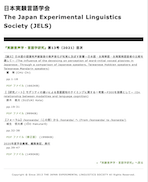Volume 13
Displaying 1-4 of 4 articles from this issue
- |<
- <
- 1
- >
- >|
Article
-
Article type: research-article
2021Volume 13 Pages 1-18
Published: March 24, 2021
Released on J-STAGE: June 15, 2023
Download PDF (1675K)
Note
-
Article type: research-article
2021Volume 13 Pages 19-31
Published: March 24, 2021
Released on J-STAGE: June 15, 2023
Download PDF (1005K)
Forum
-
Article type: other
2021Volume 13 Pages 32-38
Published: March 24, 2021
Released on J-STAGE: June 15, 2023
Download PDF (1990K)
Memoranda
-
Article type: other
2021Volume 13 Pages 39-47
Published: March 24, 2021
Released on J-STAGE: June 15, 2023
Download PDF (1490K)
- |<
- <
- 1
- >
- >|
